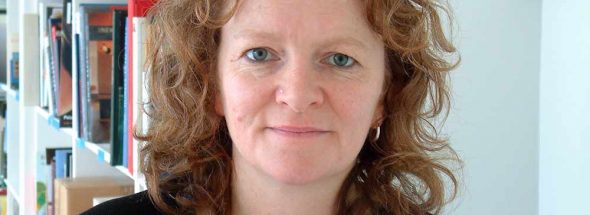This inverted process of casting, in which air and space translate into a solid mass, has been fundamental to the artist’s practice since her earliest works that date from the 1990s. It is a sculptural approach that has allowed Whiteread to index domestic interiors that are mostly overlooked or ignored, imbuing them with a sense of immortality and, in turn, memorializing history through space. Such notions prevail here, with the sculptural panels of the house animating precise surface textures and readily missed details, such as electrical sockets. The work is experienced in two parts, the cast panels of the house initially appearing outside of the building before continuing inside. “I liked the idea of somehow repeating the images,” Whiteread says. “I was thinking about wall drawings, of reliefs that go on walls.” Her preoccupation with the everyday spaces that we inhabit, in relation to how we think about time and memory, led the artist to the history of transitional housing at the beginning of the twentieth century. “I started looking into the origins of flat-pack houses and started to see these architectural patterns,” the artist explains. The “patterns” Whiteread used refer to the numerous models of homes advertised to aspiring homebuyers through extensive catalogs during this time. The house that was eventually devised by the artist resulted from the original plans; only the dimensions were amended to fit the specifications of the embassy building. The symbolic presence of U.S. Embassy (Flat pack house) certainly appeals to the
public site in which it is displayed—a building that revolves around the notion of being far away from home. When making the work, Whiteread was just as aware of those moving to America in search of a better life as she was of Americans grappling with a changing nation. The complexities attached to what Whiteread describes as “this sort of grand promise of a new life” form the basis of U.S. Embassy (Flat pack house). As the stark simplicity of each cast suggests, Whiteread’s dwelling is “straightforward and normal…I wanted a regular place.”
Whiteread first came to public attention with House (1993), a life-sized replica of the interior of a terraced house in London’s East End, which involved filling the building with liquid concrete and then stripping off the exterior—the house itself—so that only the impression of its innards remained. Whiteread received a master’s degree in sculpture from the University College London Slade School of Art in 1987, although she first experimented with casting while studying for a degree in painting at Brighton Polytechnic in England. Seeking “a way of making things more alive,” Whiteread took a class taught by sculptor Richard Wilson. “I got a spoon and pressed it into some sand. Then I pulled it out and poured metal into that area and sort of made a spoon. But it had lost its spoonness,” she explains. “That was the first thing I made that made me think about how you could simply change the nature of an object by just doing this simple process. It really started from there.” Having spent the last three decades developing a practice that explores how human presence becomes embedded within the environment, Whiteread is keen for her works to become part of the spaces they inhabit. “I wanted to make something that was very quiet,” she says of her Embassy commission, “that had a presence when you discovered it. I think that’s an important way of looking at it.”

